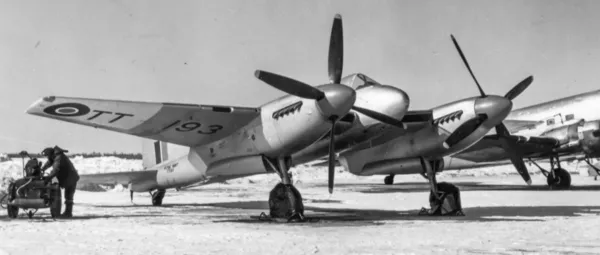Sea Hornet (Total: 1, Canadian: 1, Group 0)
de Havilland Sea Hornet

de Havilland DH.103 Sea Hornet F. 20 (1), (Serial No. TT193)
The Hornet was designed with the possibility of naval service on carriers firmly in mind. To this end good low-speed handling was required, along with good all-round visibility for the pilot. The basic Hornet design excelled at meeting these requirements. Shortly after the first Hornet prototype flew, Specification N.5/44 was issued to de Havilland, covering the modification of the Hornet for naval service. The Heston Aircraft Company was contracted to carry out the conversion work on three early production F.1s. The work entailed altering the wings to incorporate folding mechanisms so that each outer wing panel, from the aileron/flap line outboard could be folded upwards and inwards at an angle. The hinges were part of the upper wing skin structure while the lower wing skins incorporated securing latches, and Lockheed hydraulic jacks were used to move the wing panels. Slotted flaps were introduced to improve low speed "flaps down" control.
The lower rear fuselage was reinforced with two additional spruce longerons designed to take the stresses imposed by the external "vee" framed arrestor hook, which was flush-mounted below the fuselage. The frame was made up of steel tubing with a forged-steel hook and was held against the fuselage by a "snap gear". Because the Hornet used the American "3-point" system of catapult-assisted takeoff, two forged steel catapult bridle hooks were fitted, one below each wing, close to the fuselage. The de Havilland rubber-in-compression undercarriage legs could not absorb the rebound energies imposed by carrier landings. They were replaced by more conventional hydraulic oleos which embodied torque links.
Merlin 133/134s (derated from 2,070Â hp (1,540Â kW) to 2,030Â hp (1,510Â kW)) were fitted to all Sea Hornets. Other specialised naval equipment (mainly different radio gear) was fitted and provision was made for three camera ports, one on each side of the rear fuselage and one pointing down. Sea Hornet F.20s also incorporated the modifications of the Hornet F.3, although the internal fuel capacity was 347Â Imp gal (1,557Â l), slightly reduced from that of the F.1. The modifications added some 550Â lb (249Â kg) to the weight of the aircraft. Maximum speed was decreased by 11Â mph (18Â km/h).
The Hornet NF.21 was designed to fill a need for a naval night fighter. Special flame-dampening exhausts were installed, and a second basic cockpit was added to the rear fuselage, just above the wing trailing edges. ASH radar equipment was placed in the rear of this cockpit, with the radar operator/navigator seated facing aft. To gain access, a small trapdoor was provided in the lower fuselage; a fixed, teardrop-shaped bubble canopy, which could be jettisoned in an emergency, provided a good field of view. At the front of the aircraft, the nose underwent a transformation with the small rotating ASH radar dish being housed under an elongated "thimble" radome. The horizontal tail units were increased in span. The effect of these modifications on performance was minimal; about 4Â mph (6Â km/h). Wikipedia
Sea Hornet Mk. XX serial TT193
s/n TT193
m/d DH.103
TT 193
Known Units:
Received for trials at Winter Experimental Establishment, Edmonton, Alberta. To civil register as CF-GUO, used for photo survey. First used by Spartan Aviation from 1950, traded to Kenting Aviation in 1952 for a P-38. Donated to Terrace, BC Air Cadets in 1955, reported buried on the airfield by 1960.last update: 2025-February-05
1948-November-10 Struck off Strength Struck off, sold. 2019-08-20
